Home > Artist > Inspiration > Buddhist Animal Care
Animal care in the Buddhist tradition
This video shows the buddhist masters Lama Zopa Rinpoche and Dagri Rinpoche reciting mantras while blessing all the beings in the ocean.
When you start meditating on the tremendous amount of suffering that animals have to undergo on our planet, you will recognize that all living beings (and yes, even the smallest insect that bugs you) want exactly the same as you: to be happy and to be free of suffering.
A quote by the Dalai Lama:

“Today, together with a growing appreciation of the importance of human rights, there is a greater awareness worldwide of the need for the protection not only of the environment, but also of animals and their rights.
Where there is a mind, there are feelings such as pain, pleasure and joy.
No sentient being wants pain, instead all want happiness.
Since we all share these feelings at some basic level, we as rational human beings have
an obligation to contribute in whatever way we can to the happiness of other species
and try our best to relieve their fears and sufferings.”
 What you can do for your pet
What you can do for your pet
Animals, such as your cat or dog, give you unconditional love & joy. There are so many things you can do for them in return in the Tibetan Buddhist way of thinking.
In these downloads you can find a few helpful Buddhist tools on how to help your pets in daily life:
![]() A Buddhist way of helping animals in daily life – PDF download
A Buddhist way of helping animals in daily life – PDF download
![]() Dieren helpen op Boeddhistische wijze – PDF download
Dieren helpen op Boeddhistische wijze – PDF download
 How you can help all animals
How you can help all animals
When you become more and more conscious and open your heart to animals you might want to help animals in the same way as Lama Zopa Rinpoche and Dagri Rinpoche do (see video above), and blow mantras on animals.
The mantras that are most used in Tibetan Buddhism to bless animals are called ‘The 5 Powerful Mantras’:
![]() The Five Powerful Mantras for Helping Animals – PDF download
The Five Powerful Mantras for Helping Animals – PDF download
![]() De 5 Krachtige Mantra’s voor het helpen van dieren – PDF download
De 5 Krachtige Mantra’s voor het helpen van dieren – PDF download
The picture above shows Lama Zopa Rinpoche blessing horses. On Youtube you can find more videos of him blessing animals with Buddhist mantras.
 When an animal is dying
When an animal is dying
When a human being has come to the end of his or her life, Buddhists recite mantras and prayers. And whenever we see an animal dying (whether it’s your pet who you love very much or a small insect that ‘bugs’ you) it is just as beneficial if we recite mantras for the animal.
First of all, we need to remind ourselves that these practices are being done in the context of the Buddhist understanding that mind and body are not the same. The body dies but the mind (or consciousness) transforms into a new rebirth, a new body.
Because the Animal Kingdom is considered a world with much more suffering and significantly less possibilities
than the human world, we want to do everything to help the consciousness of the animal find a higher rebirth.
A very important condition for a better rebirth is that the animal has a calm mind at the time of death.
For more advice see:
![]() When an animal is dying or has died – PDF download
When an animal is dying or has died – PDF download
![]() Wanneer een dier stervende is of reeds gestorven – PDF download
Wanneer een dier stervende is of reeds gestorven – PDF download
Want to read more?

Enlightenment for the Dear Animals

Enlightenment for the Dear Animals is a project to help people to benefit animals. Their website is a resource for Buddhist students, Buddhist centers and diverse projects by providing news, advice and linking people and projects who are helping animals around the world.
As fellow sentient beings, animals are not just creatures to whom we should do no harm, they are beings who have the potential for enlightenment (just as we have) and therefore we can assist them in meaningful ways to achieve happiness and freedom from suffering.
Animal Liberation Sanctuary
The Animal Liberation Sanctuary is a project near Kopan monastery in Nepal. The object of the sanctuary is to house animals that were to be killed so that they may live out the natural course of their lives in peace and gain a higher rebirth.
The sanctuary is being created on behalf of Lama Zopa Rinpoche (see above) and will be the first of many animal sanctuaries throughout the world.
The sanctuary will give rescued animals an opportunity to gain a better rebirth, because not only will they be freed from impending death but they will also be exposed to the Dharma.
As you can also see in the video on top of this page, Lama Zopa Rinpoche himself gives many blessings and recites mantras continuously to benefit animals and it is planned that the rescued animals will regularly hear mantras and be led around the stupas to create merit
When animals are ill or dying there are a number of practices that you can do, and mantras that you can recite.




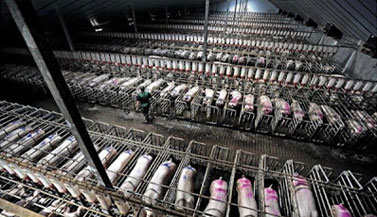 That chickens are piled up in small cages in battery farming.
That chickens are piled up in small cages in battery farming.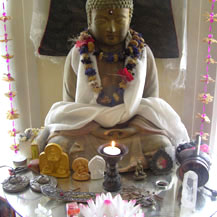 Buddhism brought an even deeper meaning to being vegetarian
Buddhism brought an even deeper meaning to being vegetarian So from ‘not eating meat’ it expanded into ‘not hurting animals’ as well; and ‘not killing insects and flies at my convenience’ anymore. Because seriously, who am I to point at an animal and say ‘You should die!’
So from ‘not eating meat’ it expanded into ‘not hurting animals’ as well; and ‘not killing insects and flies at my convenience’ anymore. Because seriously, who am I to point at an animal and say ‘You should die!’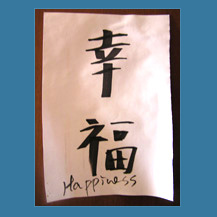





 Base of a Mandala
Base of a Mandala




 The Buddha Flag Project
The Buddha Flag Project
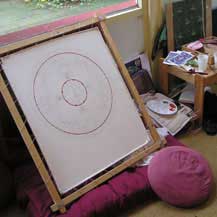
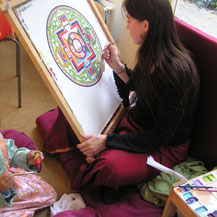





 On the page
On the page 






































 Buddhism
Buddhism


 And before I knew it, the Dalai Lama, surrounded by body guards, walked down the stairs of the temple, friendly smiling, notting and waving to all the monks and nuns present. I was the only tourists present and was able to make a few pictures with my camera.
And before I knew it, the Dalai Lama, surrounded by body guards, walked down the stairs of the temple, friendly smiling, notting and waving to all the monks and nuns present. I was the only tourists present and was able to make a few pictures with my camera.









 Cornelis le Mair
Cornelis le Mair 